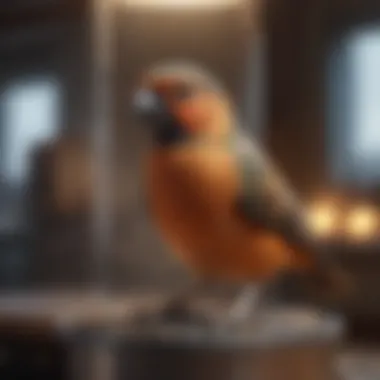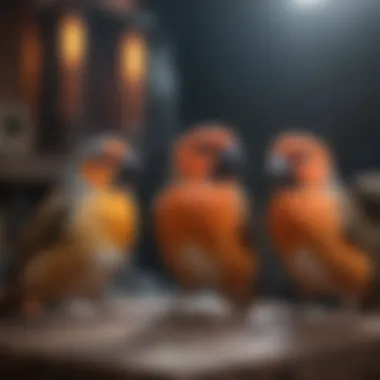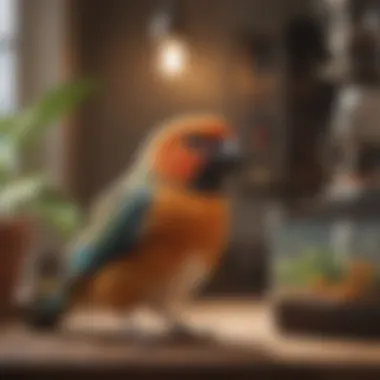Ensuring Safety of Space Heaters Around Pet Birds


Intro
In discussing the safety of space heaters in homes with pet birds, nuanced understanding is vital. Birds have delicate respiratory systems and heightened sensitivity to environmental factors. Therefore, while managing home temperature is critical, it must be done with caution and insight into aviary needs. This article explores the complexities surrounding the use of space heaters, including specific risks to pet birds, their physiological needs, and guidelines for safety. Understanding these elements is essential for responsible bird ownership.
Avian Care Basics
Ensuring the health and well-being of pet birds requires a strong foundation of care that considers various facets of their life.
Importance of Proper Nutrition
Nutrition plays a crucial role in supporting a bird's immune system and overall health. Birds require a balanced diet that includes seeds, pellets, fresh fruits, and vegetables. Each type of bird species has unique nutritional needs, making it essential for owners to research and apply appropriate dietary guidelines.
Understanding Bird Species and Their Needs
Every bird species is different when it comes to habitat and care. Large parrots, finches, and canaries all have their own requirements. For instance, larger birds may require more social interaction than smaller breeds. Understanding these nuances aids in meeting their specific demands.
Basics of Birds Habitat Setup
A safe and engaging habitat is vital. Options include spacious cages combined with play areas. Additionally, ensure the environment is free from pollutants that can exacerbate respiratory sensitivities. Plants, toys, and appropriate perches contribute to a stimulating space.
Grooming and Hygiene Tips
Regular care is important. Routine health inspections, feather maintenance, and cage cleaning are all essential steps to prevent illness. Grooming helps in spotting any unusual signs in behavior or physical health early, providing crucial preventative care.
Interacting with Your Pet Bird
Trust-building with birds is essential for a healthy relationship. Proper interaction considers the unique temperaments of pet birds.
Building Trust and Connection
Spend time near their cage before attempting to touch or handle them. Patience is critical; trust will develop over time as the bird becomes accustomed to your presence. Positive reinforcement works well in this bonding process.
Training Techniques and Tips
Training is beneficial for both owners and birds. Simple commands can establish routines that enhance safety, particularly when exposed to other household items like space heaters. Start with single-word commands and increase complexity as the bird learns.
Fun Activities for Bird Owners and Their Birds
Engaging in interactive activities helps in developing bonds. Toys, puzzles, and training sessions all stimulate mental and physical activity in birds ensuring psychological well-being. Create environments that promote exploration and learning.
Recognizing Bird Cues and Behaviors
Understanding behaviors is critical for effective communication. Noticing shifts in their body language can signal discomfort or illness. Knowledge about normal versus abnormal behavior allows for timely responses to their needs and concerns.
Emotional Well-Being of Birds
Keeping birds comfortable in their environment fosters emotional health. Active environments can significantly improve mental status in pet birds.
The Role of Play and Socialization
Birds benefit from companionship and social interaction. Encourage playtime outside the cage in a monitored space. This sort of engagement reduces stress and enriches their lives.
Enhancing Birds' Emotional Health
Consider music or soothing sound from nature to provide comfort. A calm environment help breeds feel safe. Enrichment activities also minimize boredom, guarding against behavioral issues based on stress.
Assessing Bird Stress and Remedies
Bird will show signs of stress when conditions are not optimal. These signals can include excessive preening, aggressive behaviors, or lethargy. Quick assessment leads to timely intervention, ensuring the comfort of a pet bird.
Building Strong Human-Bird Bonds
Investing time in interaction establishes a close connection with a bird. Regular bonding exercises create trust and an enjoyable shared experience that lasts long term.
Bird Health and Safety
Monitoring health is empowering for owners. Regular checks reflect the well-being of your pet and signal if alterations are required.
Common Health Issues and Prevention


Recognizing signs of common phenomena like feather plucking, respiratory distress, or malnutrition is critical. Providing a varied diet, clean housing, and regular veterinary visits are preventive steps to ensure long-term health.
Routine Veterinary Care
Control measures include braiding safe practices in the home and performing scheduled vet check-ups. Choose veterinarians specializing in exotic birds to gain relevant insights and thorough knowledge on avians.
Environmental Hazards to Avoid
Birds are sensitive to fumes and pollutants; space heaters can impact air quality. Some products may emit harmful substances that pose a hidden danger. Be aware of factors like temperature adjustments and personal protective measures in your heating choices.
Signs of Illness or Distress
Persistence in observing behavior pattern shifts translates into recent illness indicators. Educate oneself on these changes safeguards prompt actionable measures and better sustenance material environments.
Fun Facts and Quirky Insights
Together, appreciation and knowledge about these creatures are limitless. Unique characteristics make them engaging pets.
Unique Traits of Popular Bird Species
Cockatoos, for instance, thrive on social interactions, while budgies show extraordinary intelligence in mimicking speech. Assess these distinct attributes when introducing new aspects into their habitat.
Historical and Cultural Significance of Birds
Cultures across the globe have recognized birds in various facets of life—symbols of freedom, love, and beauty. Understanding their history adds depth to their role in our lives.
Famous Bird Owners and Their Stories
Many influential personalities have cherished their pet birds; one notable example includes businessman Richard Branson's affinity for avians, which he credits for joy and companionship. Such real-life implications mirror the importance of birds in human lives.
In reflecting on the significant role of nonhuman companions, pet owners connect with their feathered companions in unique ways, often promoting mental health positivity and improving quality of life.
Through this exploration, it becomes evident that safe space heater management is a critical issue intertwined with pet bird care and safety. Applying the knowledge regarding environment and bird-specific needs ensures each home can become a warm welcome for both birds and their owners.
Prelims
The discussion surrounding the safety of space heaters is paramount for pet bird owners. Space heaters offer a feasible way to regulate temperature in homes, particularly in colder months. However, their use poses significant risks to avian health. As birds are highly sensitive to temperature fluctuations, it is critical that their environment remains at a consistent and safe degree.
Understanding what pet birds require is fundamental. Their high metabolism and unique physiology make them particularly vulnerable to both cold and excess heat. Failing to maintain optimal conditions can lead to health complications, even fatal ones. This necessity for balancing a warm home with safety precautions makes this topic highly relevant for bird owners since many lack adequate information about the risks associated with these heating devices.
The article will delve into various aspects of space heaters, focusing on different types and their potential hazards. When selecting a heat source, bird owners must make informed decisions to effectively ensure the welfare of their pets. By analyzing how space heaters affect birds, we aim to offer insights that can help mitigate risks linked to temperature management. Such information will offer vital assistance to individuals who aspire to provide the safest environment for their feathery companions.
In the following sections, the article will detail the specific needs of avian species to outline best practices and alternative heat management strategies that keep birds' welfare at the forefront.
Types of Space Heaters
Understanding the various types of space heaters is essential for pet bird owners, as each type has its own advantages and potential risks for avian health. It is critical to assess how these heaters function, their heat distribution, energy efficiency, and safety features. Selecting a suitable heater can help maintain a comfortable environment without jeopardizing the well-being of pet birds.
Electric Heaters
Electric heaters are a common choice for many homeowners. They are often portable and easy to use. These heaters convert electrical energy into heat, resulting in quick rise in room temperature. However, pet bird owners should be careful when using these heaters.
Considerations for Electric Heaters:
- Heat Output: These heaters can sometimes produce intense heat if not placed at an appropriate distance from the birds. Ensure adequate space between the heater and the cage.
- Air Quality: They typically do not impact humidity levels, which means air quality may successfully maintain. However, those that have built-in fans might circulate air drafts, potentially chilling a bird.
- Toxic Components: Some electric heaters use materials that can off-gas harmful substances. Regular inspection can reduce risks of inhaling toxins.
Overall, while electric heaters provide great convenience, caution is important to ensure birds stay safe.
Ceramic Heaters
Ceramic heaters emit warmth using a ceramic element that heats up quickly. They are known for producing heat that feels gentle and consistent. One significant advantage is their ability to retain heat longer after they are turned off, thus lessening potential cold drafts in the area.
Key Points About Ceramic Heaters:
- Gradual Heating: These heaters warm up more slowly, making them less likely to create drastic temperature changes, which can be stressful to birds.
- Energy Efficiency: Many ceramic heaters are designed to use less electricity without sacrificing performance, making them a thoughtful choice for environmentally conscious pet owners.
- Safety Features: Often equipped with automatic shut-off systems and cool-to-touch exteriors, ceramic heaters can reduce the likelihood of burns or other hazards.
For households with birds, these features present a relatively safer option for keeping spaces comfortable.
Infrared Heaters


Infrared heaters operate differently from traditional electric models. They produce infrared radiation, which heats objects directly, including pets, instead of just warming the air. This can create a cozy environment but still comes with potential risks.
Aspects of Infrared Heaters:
- Direct Heating: Birds may benefit directly from the heat without the harsh industry winds created by conventional heaters. This can be good for keeping them warm during colder months.
- Temperature Consistency: Infrared heaters provide a more stable heating experience with little fluctuation in temperature after reaching desired heating level.
- Ventilation Needs: Given that infrared heaters depend on radiant heat, areas should ideally keep fresh air circulating. Lack of appropriate ventilation can create a stagnant environment, which is detrimental for birds.
Many bird owners may find infrared units beneficial, provided precautions are taken to ensure birds do not stray too close to the heat source unmonitored.
By understanding the different types of space heaters, pet bird owners can make informed decisions while ensuring their feathered companions thrive in a safe, warm setting. Each heater's characteristics can directly affect how birds respond to their environment, underscoring the importance of diligent selection.
Risks to Birds from Space Heaters
Understanding the risks associated with various heating devices is fundamental for bird owners. Space heaters can provide necessary warmth, especially during colder months, but they can pose significant hazards if not used properly. The delicate nature of avian physiology requires careful consideration to ensure their safety.
Temperature Regulation
One of the primary concerns with space heaters is temperature regulation. Birds have a narrow thermal comfort range. If room temperatures become excessively high or low, it can have detrimental effects on their health. Exposure to overheating can cause heat stress, leading to signs such as excessive panting and listlessness.
Proper monitoring is essential. Aim to keep the temperature steady, ideally between 65°F to 80°F, depending on the bird species. Poor temperature control may confuse bird behavior, affecting their activity levels and overall wellbeing. Setting schedules for heater use can help in achieving stable room temperature.
Furthermore, certain space heaters may exhibit uneven heat distribution, resulting in hot and cool spots throughout the space. Ensuring that the heater is not placed too close to your bird, typically a minimum of three feet away, can mitigate such risks.
Potential Exposure to Toxic Fumes
The potential for exposure to toxic fumes is another critical risk that pet bird owners must mitigate. Common space heaters, such as fuel-burning types, can emit harmful gases like carbon monoxide or volatile organic compounds. Birds have an efficient respiratory system, which, while beneficial for most purposes, also means they can be disproportionately affected by these toxins. Their small size magnifies the impact of even low-level exposure.
Owners must take care to choose heaters that are explicitly safe for use around birds. Avoid those with materials that may off-gas harmful substances when heated, notably those made from plastic or low-quality metals. Always check for warnings regarding the proper ventilation of the heater type being used in proximity to your feathered friends.
Heat Sensitivity in Birds
Understanding heat sensitivity is vital for maintaining a safe environment for pet birds. Unlike humans, birds have unique physiologies, which influence their reactions to heat. Shelling light on these responses helps bird owners take necessary integrations to prevent illnesses or stress incidences. It also aids in harmonizing heaters and temperature adjustments that benefit avian companions.
Behavioral Responses to Heat
Birds may exhibit various behavioral responses when exposed to heat. Typically, one of the first indicators that a bird feels too hot is an increase in panting. This behavioral change is similar to how mammals like dogs manage kami excess body heat. When overheating, some birds also lift their wings away from the body to promote cooling shape against surrounding air. If providing a place where birds can fly freely, their continual movement may also act as a form of slightly cooling.
Another notable behavior relates to water intake. Birds tend to drink more water when they find themselves in hotter conditions. Adequate hydration is necessary to facilitate physiological functions and stave off conditions like dehydration. Proper observation can reveal when a bird breeds weaker, colors between the feather begin to fade, or its sheen disappears, signalling heat distress.
Physiological Effects of Excessive Heat
Excessive heat can profoundly affect the physiology of birds. One important aspect is thermoregulation. Under consistent high temperatures, birds rely significantly on their respiratory system for temperature control. Conditions like heatstroke can arise if the core temperatures rise too high. Symptoms of heat stress can include lethargy, extreme panting, and sudden collapse.
The detrimental effects also extend to metabolic functions. Heat impacts the bird's metabolism, increasing their energy requirements. With limited energy stores starting to deplete, this imbalance can lead to muscle wasting and even death in severe cases.
Additionally, high temperatures coupled with improper humidity levels can create a dangerous combination. Birds experiencing prolonged periods of heat and damp air interfaces may become vulnerable to fungal infections, anisakiasis or respiratory diseases, which can markedly impair their health.
Therefore, maintaining stable ambient temperature is invaluable for keeping pet birds safe from heat challenges.
Understanding these behaviors and physiological responses contributes significant knowledge to creating a safeguarded habitat for pets. Owners play a crucial role in monitoring their birds while creating an environment where the heat is manageable thus aiding in their well-being.
Best Practices for Using Space Heaters Around Birds
Using space heaters to maintain warmth in environments where birds reside requires a careful approach. The best practices provide a framework to ensure that the wellbeing of these sensitive creatures is prioritized.
Maintaining Safe Distances
It’s important to ensure that space heaters are positioned away from cages and areas where birds frequently perching. This is to avoid direct heat exposure which can lead to stress or even health issues like overheating. General recommendations suggest a minimum distance of three to five feet, but this may vary depending on heater type. Keeping a distance not only protects birds but also allows for more even temperature distribution around the room. Besides, fixtures like curtains or blinds should be kept at a safe distance too, as getting too close to a space heater may create unnecessary risks of fire.
Regular Monitoring of Temperature and Air Quality
Monitoring temperature and ensuring good air quality is paramount in homes with birds. Birds are particularly sensitive to fluctuations in temperature. Utilising thermometers to regularly measure ambient temperatures helps prevent situations where they may become too cold or hot. Additionally, space heaters can influence air quality, sometimes generating odors or emitting fumes. An air quality monitor can alert to changes. Implementing these practices keeps the avian companions in a healthy space. Investing in humidity gauge is also useful. Improper humidity can be harmful to birds, specifically hyacinths and parakeets.
Choosing the Right Heater Type
The selection of the appropriate space heater is crucial for a safe home environment for birds. Electric heaters such as oil-filled radiators are usually safer options compared to conventional models since they tend to operate at lower surface temperatures. Ceramic heaters are known for delivering a gentle and consistent heat. Conversely, infrared heaters directly warm objects and may cause hot spots, paying close attention to placement and distance is necessary. Always carefully study heater specifications to ensure they comply with safety standards. Consider features like automatic shutoff and overheat protection to reduce risks. These factors are principal when aiming to provide warmth without compromising safety.
There is no substitute for diligence and care. Understanding the dynamics of heat in conjunction with bird needs can ensure their safety.
By following these best practices, bird owners not only keep their pets comfortable but also enhance their overall wellbeing in shared living environments.


Alternatives to Space Heaters
Considering the safety of pet birds around heating devices, alternatives to space heaters can provide effective ways to maintain a cozy environment without posing risks. While many agree that space heaters are effective for temperature regulation, they can emit harmful substances or pose other risks that could affect the health of your birds. Examining alternative methods can lead to safer and more stable warmth solutions for households with avian residents.
Using Central Heating Systems
Central heating systems are an excellent alternative to using space heaters. These systems distribute heat evenly throughout the home, reducing any hot spots which could overheat the area around the birds. Assure that the central system has proper ventilation, as good airflow can also benefit the sanity of the air that pet birds breathe.
When engaging with central heating:
- Check thermostat settings to avoid overheating.
- Maintain regularly to ensure efficient operation and avoid breakdowns.
- Consider zone heating, to permit variable temperature control in different areas.
Though this system often requires a larger investment, the long-term safety benefits should not be overlooked.
Employing Heating Pads and Blankets
Heating pads and blankets provide targeted heat and can be particularly useful for creating warm areas in specific locations. This method can be gentler and tailored to areas where birds reside—for instance, offering warmth near perches or inside cages. Many of these products are low-energy and can minimize the risk linked to overexposure to high temperatures.
- Select padded options featuring an adaptive heat feature to prevent overheating.
- Be mindful of electric versions. Always supervise their usage and replace any worn items.
- Consult with an avian vet, to confirm their safety for birds, since some materials can be harmful if chewed or stepped upon.
This alternative can provide warm spots that allow birds to access heat when necessary while giving them the choice to move away if they feel too warm.
Creating a Warm Environment with Bird Safety in Mind
To create a warm environment that ensures bird safety, start with the simple actions of sealing drafts and ensuring window cover. Correct insulation keeps temperatures more consistent and avoids sudden drops at night.
Essential Steps:
- Employ curtains or window film to retain warmth and block drafts.
- Place bird cages away from direct radiators or ventilators; birds can be sensitive to sudden temperature fluctuations.
- Monitor humidity levels; while birds prefer warmth, excessive dryness can also be harmful.
Fosters an environment that feels secure and inviting for birds to enjoy. By adopting a mix of these methods, you can lower risks involved with using heaters while providing suitable warmth. %emphasis on kindness% to your pet is eternal.
“Creating a nurturing space resonates more than heating—integrate comfort with awareness.”
Closure
Summary of Key Points
In summary, here are some essential considerations discussed:
- Types of Space Heaters: Various heaters like electric, ceramic, and infrared have unique properties and potential risks when near birds.
- Risks to Birds: The impact of temperature fluctuations, potential toxins from some heaters, and fire hazards are significant risks to consider.
- Bird Physiology and Behavior: Understanding how birds respond to heat helps owners make informed choices about their heating methods.
- Best Practices: Recommendations such as maintaining safe distances between heaters and bird areas, regularly monitoring indoor climate, and choosing safer heater models are pivotal.
- Alternatives to Heating: Discussing central heating, blankets, and controlled environment spaces assists in minimizing risks while ensuring comfort for pet birds.
Final Recommendations for Bird Owners
For pet bird owners, practical steps can be taken to protect their feathered friends:
- Evaluate the Heater Type: Choose a space heater designed to operate safely in environments with pets. Check for certifications and read reviews from other experts.
- Distance Matters: Always keep heaters at a safe distance from bird enclosures. Place them in areas that do not permit accidental contact or overheating.
- Monitor Temperature: Invest in thermometers and sensors to monitor the room temperature, further declarations made regarding necessary adjustments based on birds' needs.
- Regularly Inspect: Conduct routine checks for any signs of soot, damage, or odd smells from heaters that might signal toxicity or impending hazards.
- Come Up with Quieter Operations: Look for silent (or quiet) operations for heaters. This helps keep stress levels minimum and comforts birds more.
By integrating these strategies, bird owners create a less risky heating environment that complements the natural needs of pet birds.
Importance of Accessing Reliable Sources
Good references ensure that the information presented is grounded in science and current practices. They validate the chosen recommendations and highlight the specifics of what makes certain heaters potentially hazardous to birds. By using a diverse array of sources, areas like bird physiology, heater technology, and environmental safety become much clearer.
Having these references helps to inform the target audience, which includes not only bird owners but also aspiring bird parents and breeders. Providing accurate recommendations based on verified data enhances the readers' trust in the content.
Benefits of a Comprehensive Bibliography
A thorough bibliography serves several essential functions:
- Verification of Facts: Citing credible sources increases reliability.
- Guidance for Further Research: Interested readers can consult original materials.
- Support for Claims: When making claims about risks or safety, referencing studies diffuses skepticism.
Considerations When Selecting References
- Choose documents from reputable journals or well-established books in the field.
- Utilize sources which are current, as older data may not represent current technologies or myths about heaters.
- Focus on firsthand accounts or research outcomes when discussing heater impacts on bird safety.
"Bird welfare is paramount and understanding our resources strengthens it."
This structure allows readers not only to engage deeply with the material but also fosters a comprehensive view of heater safety in homes with pet birds. Careful scrutiny of references creates a knowledge foundation that both demonstrates an expert handle on the topic and reinforces bird owners' commitment to their pets' wellbeing.
Bibliography of Sources
In concluding this article, below are sources that have informed our assessment of the safety of space heaters around pet birds:
- Wikipedia: Pertinent information on space heaters and their mechanics.
- Britannica: Articles shedding light on heat safety and bird physiology.
- Reddit: Discussions offer real-life insights from other pet bird owners and experiences with space heaters.
- Facebook: Groups provide shared knowledge and peer responses to common queries about keeping birds safe around home heating devices.















